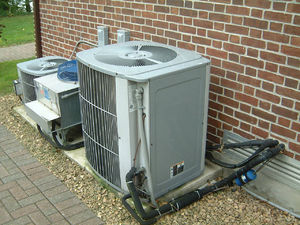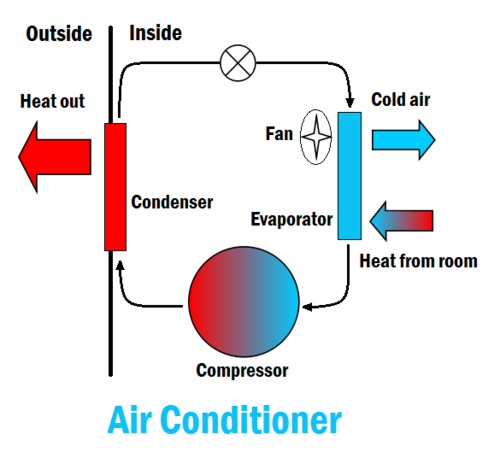Air conditioner

An air conditioner is a system that is used to cool down a space by removing heat from the space and moving it to some outside area. The cool air can then be moved throughout a building through ventilation. Air conditioners require some input of work to operatre, otherwise entropy would decrease naturally which is forbidden by the Second law of thermodynamics. Air conditioners act similarly to a heat pump, but instead follow a cooling cycle. This cooling cycle can be seen in Figure 2. To cool, a substance known as a refrigerant is processed in the following steps:[2]
- A cold liquid refrigerant absorbs heat from the hotter room in the evaporator, cooling the room down.
- The refrigerant then changes phase to a gas and is put through a compressor to increase its temperature.
- Refrigerant then passes through the condenser coils, transferring heat from the refrigerant to the outside air.
- Refrigerant expands in order to decrease its pressure and cool down to below the room's temperature to repeat the cycle again.
The air conditioner is a key component of the HVAC system, which focuses on home temperature control in order to maximize comfort and livability in a space.

Air conditioners are called "split-systems" because there is an outdoor unit (the condenser) and an indoor unit (the evaporator).[4] These two systems work together to accomplish the task of cooling an interior space while also dehumidifying it. This dehumidification happens as warm air from inside passes over the cold evaporator, where the warm air condenses and loses moisture, just like warm air does on a cold glass of lemonade.[4]
The split-system describes an air conditioner with separate indoor and outdoor components. There is also another type of air conditioner which combines these components into one outdoor system, known as a "packaged" system.
For Further Reading
- Heat
- Cooling cycle
- Refrigerator
- HVAC
- Home temperature control
- Or explore a random page
References
- ↑ Wikimedia Commons[Online], Available: http://commons.wikimedia.org/wiki/File:Air_conditioner_armaflex_insulation.jpg
- ↑ R. A. Hinrichs and M. Kleinbach, "Home Energy Conservation and Heat-Transfer Control," in Energy: Its Use and the Environment, 4th ed. Toronto, Ont. Canada: Thomson Brooks/Cole, 2006, ch.5, sec.G, pp.149-153
- ↑ Figure created internally by a member of the Energy Education team.
- ↑ 4.0 4.1 Consumer Energy Center, Central Heating Ventilation and Air-Conditioning (HVAC) Systems [Online], Available: http://www.consumerenergycenter.org/residential/heating_cooling/heating_cooling.html

